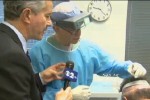Q: What is the most common cause of necrosis (death of tissue) in the recipient area? — A.Q., Los Altos Hills, C.A.
A: Recipient site necrosis is one of the worst complications of a hair transplant and results in skin ulceration and scarring. Usually it is caused by a combination of a few or many factors. Each by itself should not present a risk. Read on for the list of risk factors.


 Dr. Bernstein was featured in a CBS News report on
Dr. Bernstein was featured in a CBS News report on  The Super Doctors 2012 list, published by Key Professional Media as a special section in the May 20, 2012 issue of New York Times Magazine, has included Dr. Bernstein as one of New York City’s best dermatologists.
The Super Doctors 2012 list, published by Key Professional Media as a special section in the May 20, 2012 issue of New York Times Magazine, has included Dr. Bernstein as one of New York City’s best dermatologists.  Dr. Bernstein not only pioneers
Dr. Bernstein not only pioneers  The January/February issue of Departures Magazine contains a feature called “The State of Plastic Surgery 2012″. The magazine covers topics such as how to find the best plastic surgeon, the use of cells in plastic surgery and the best hair loss therapies.
The January/February issue of Departures Magazine contains a feature called “The State of Plastic Surgery 2012″. The magazine covers topics such as how to find the best plastic surgeon, the use of cells in plastic surgery and the best hair loss therapies. 



